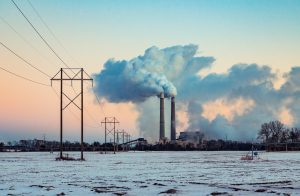
Former Coal Lobbyist Andrew Wheeler – Now Running the EPA – Puts Coal Profits Ahead of Public Health
Washington, D.C. – The Trump Administration’s Environmental Protection Agency today proposed to cut deeply into water pollution control regulations for toxic chemicals discharged from coal-fired power plants, the largest industrial source of toxic water pollution in the U.S.
EPA Administrator Andrew Wheeler, a former coal industry lobbyist, signed a proposed regulation this morning to replace a 2015 rule known as the Effluent Limitations Guidelines (or “ELG Rule”) for electric power plants.
The revised regulation weakens pollution limits, extends compliance deadlines, and exempts many coal-fired power plants, allowing them to discharge high amounts of mercury, selenium and other toxic chemicals.
“This administration will stop at nothing to save the coal industry a few bucks,” said Abel Russ, Senior Attorney for the Environmental Integrity Project. “Earlier this year, the U.S. Fifth Circuit Court of Appeals bounced this rule back to EPA, demanding that the Agency make it stronger. EPA’s proposal today would make it weaker instead. So much for the rule of law.”
For a copy of the proposed new rule, click here.
As part of its rulemaking package, EPA appears to be assuming that many coal plants will opt for stricter, voluntary standards, despite the fact virtually no one showed any interest in a similar voluntary program in the 2015 rule.
“EPA uses the assumption that about 30 percent of the plants will voluntarily install more stringent treatment to hide the fact that the new rule results in greater pollutant loadings and worse environmental impacts than the 2015 rule. That is simply dishonest.” said Dr. Elizabeth Southerland, former director of science and technology in EPA’s Office of Water. “At no place in this new rule does EPA show how much pollution would be discharged if none of the power plants choose to employ the voluntary technology, which is a likely outcome.”
Coal fired power plants discharge over 1 billion pounds of pollutants every year, impacting thousands of miles of rivers and contaminating the drinking water and fisheries of 2.7 million people.
After lawsuits from the Environmental Integrity Project, Earthjustice and other allies, EPA in 2015 imposed a regulation that, for the first time, required coal plants to treat the toxic wastewater generated when air emission filters called “scrubbers” are cleaned. The 2015 rule also required the toxic ash from burning coal to be disposed of in dry form instead of being washed into ponds known to leak or overflow.
The rule went into effect on January 4, 2016, and the water pollution controls originally had to be installed by most power plants between 2018 and 2023. In 2017, the Trump Administration postponed compliance deadlines until EPA could formally weaken the rules. And on Thursday, EPA Administrator Wheeler released the revision.
The new rule would weaken water pollution controls in several ways:
- The Trump regulation requires less effective treatment of wastewater than the 2015 rule, which will result in increased selenium pollution discharges and periodic releases of contaminated water from coal ash handling.
- For wastewater discharged from air pollution scrubbers, the rule gives the industry an extra two years to comply.
- The rule exempts many coal-fired power plants from even these requirements, allowing them to discharge high levels of mercury, selenium and other toxic chemicals.
It is also worth noting what the rule does not do. In April of this year, the Fifth Circuit Court of Appeals vacated parts of the Obama Administration EPA’s 2015 ELG rule – limits on two waste streams from coal plants known as leachate and ‘legacy waste’ (wastewater generated before the 2020-2025 timeframe) – because they were not strong enough. EPA has so far failed to respond to that court ruling, prioritizing giveaways to industry over its legal obligations.
EPA also announced today a proposal to revise a 2015 coal ash disposal rule to set timelines for closure of unlined surface waste ponds, as required following a major victory secured by EIP and our partner groups on August 21, 2018. In that decision, a federal appeals court struck down portions of EPA’s 2015 coal ash waste disposal rule, deeming EPA’s failure to require closure of unlined ponds and its classification of ponds lined with clay as “lined” to be arbitrary and capricious and ordering EPA to change the rule. Today’s EPA proposal would:
- Require unlined surface waste ponds to cease receiving waste (and thereby initiate closure) by a default deadline of August 31, 2020
- Require waste ponds that failed to establish a 5-foot distance from groundwater to cease receiving waste by a deadline of August 31, 2020; and
- Reclassify clay-lined or soil-lined surface waste ponds as “unlined.”
However, the weaknesses of the proposed rule include that:
- It includes short- and long-term extensions to the deadline for initiating closure due to lack of alternative capacity to November 2020 or October 15, 2023;
- It allows surface impoundments to continue receiving CCR despite the new proposed deadlines if they commit to ceasing operating coal-fired boilers and completing closure by October 17, 2023 (for units 40 acres or smaller) or by October 17, 2028 (for units larger than 40 acres); and
- It fails to address all of the aspects of the appeals court ruling, including failing to respond to the court’s ruling striking down EPA’s decision to exempt inactive ponds at inactive power plants from the entirety of the 2015 CCR rule.
There will be an online public hearing on Thursday, December 19 at 1:00 pm EST.
Media contact: Abel Russ, Environmental Integrity Project (802) 482-5379 or aruss@environmentalintegrity.org


